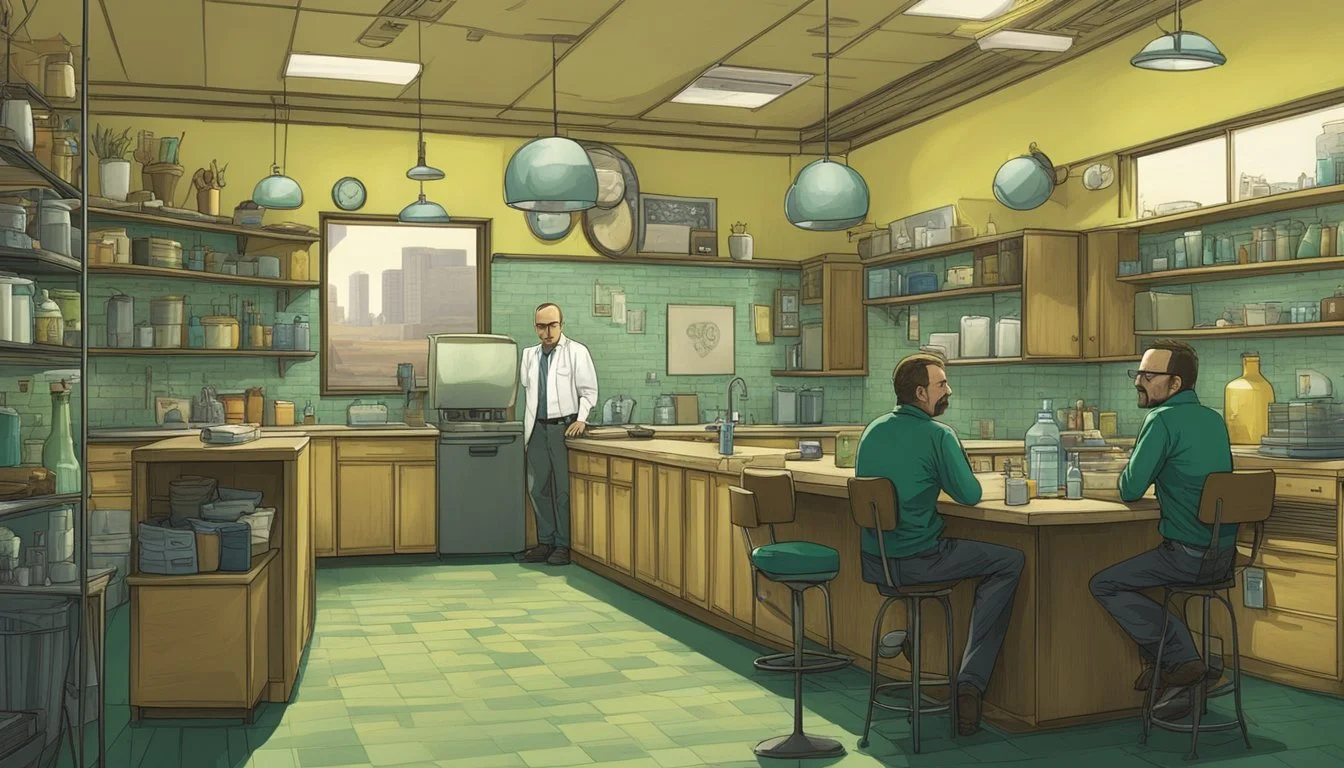The Art of the Cold Open: Breaking Bad's Memorable Episode Beginnings
Mastering Narrative Hooks
Breaking Bad revolutionized television storytelling, and its cold opens were a key ingredient in the show's success. These pre-title sequences captivated audiences with their creativity, tension, and ability to set the tone for each episode. Breaking Bad's cold opens masterfully combined intriguing visuals, compelling dialogue, and unexpected twists to hook viewers from the very first moments.
Vince Gilligan and his team used cold opens to provide glimpses into characters' pasts, foreshadow future events, or present standalone vignettes that enriched the show's universe. From the iconic teddy bear in the pool to Walter White's desert confession, these openings became an art form in themselves. They often employed non-linear storytelling, revealing crucial information or raising questions that kept audiences eagerly anticipating the rest of the episode.
The cold opens in Breaking Bad demonstrated the power of visual storytelling and the impact of carefully crafted scenes. By setting the stage with these memorable beginnings, the show elevated the television viewing experience and raised the bar for narrative techniques in the medium. AMC's willingness to embrace this innovative approach allowed Breaking Bad to push creative boundaries and cement its place as one of the most critically acclaimed series of all time.
The Role of the Cold Open in Breaking Bad
Breaking Bad's cold opens served as powerful narrative devices, setting the tone for each episode and the series as a whole. These pre-title sequences captivated viewers and established the show's unique storytelling style.
Defining the Cold Open
A cold open, also known as a teaser, is a short scene that precedes the opening credits of a television show. In Breaking Bad, these sequences often lasted several minutes and varied widely in content and style. Some cold opens directly continued the previous episode's plot, while others presented seemingly unrelated vignettes or flashbacks.
Breaking Bad's cold opens frequently employed striking visuals or unexpected scenarios to hook viewers immediately. Examples include the pink teddy bear in the pool, the Mexican shrine to Heisenberg, and Walt's 52nd birthday breakfast.
Importance in Serialized Dramas
Serialized dramas like Breaking Bad benefit greatly from effective cold opens. These sequences help maintain narrative momentum between episodes and seasons. They also provide opportunities to explore character backstories or introduce new plot elements without disrupting the main storyline.
Breaking Bad's cold opens often contained crucial information or foreshadowing that viewers would only fully understand later in the series. This technique encouraged audience engagement and rewarded attentive viewing.
The show's cold opens also allowed for experimentation with different storytelling techniques, adding variety to the viewing experience.
Contribution to Tension and Foreshadowing
Cold opens in Breaking Bad frequently built tension by presenting mysterious or dangerous situations without immediate context. This approach left viewers eager to discover how these scenes connected to the larger narrative.
Many cold opens foreshadowed future events or character development. The teddy bear sequences in season 2, for example, hinted at an impending disaster without revealing its nature or cause.
These openings also established mood and atmosphere, preparing viewers for the emotional tone of the episode to follow. By carefully crafting these sequences, the show's creators enhanced the overall viewing experience and kept audiences invested in the story.
Iconic Cold Opens and Their Significance
Breaking Bad's cold opens set new standards for television storytelling. These openings captivated audiences with their creativity, foreshadowing, and narrative depth.
The Opening of 'Negro y azul'
The cold open of "Negro y azul" features a narcocorrido music video. This unique start showcases the growing legend of Heisenberg in the criminal underworld.
The song's lyrics detail Walter White's rise to infamy. Its upbeat tune contrasts sharply with the violent imagery.
This cold open emphasizes the far-reaching consequences of Walt's actions. It demonstrates how his alter ego has become a mythical figure in the drug trade.
The use of a non-English song highlights the international scope of the meth business. It also foreshadows the increasing danger Walt faces as his reputation grows.
'Half Measure' and Its Intensity
The "Half Measure" cold open presents a tense confrontation between Mike and Walt. This scene sets the stage for a crucial lesson in the criminal world.
Mike's monologue about his past as a cop reveals the dangers of taking half measures. His story serves as both a warning and a turning point for Walt.
The quiet intensity of the scene underscores the gravity of Mike's advice. It foreshadows the brutal decisions Walt will face in his pursuit of power.
This opening reinforces the show's themes of moral decay and the consequences of compromise. It also deepens Mike's character, revealing his complex past and worldview.
The Poignancy of 'Fly'
The "Fly" cold open focuses on a seemingly insignificant insect in Walt's lab. This minimalist opening sets the tone for an episode exploring obsession and guilt.
The fly becomes a symbol of Walt's deteriorating mental state. Its presence represents the contamination he fears in both his product and his life.
This opening's simplicity contrasts with the complex emotions it evokes. It hints at Walt's growing paranoia and his need for control.
The fly also serves as a metaphor for the small details that can unravel carefully laid plans. This theme resonates throughout the series as characters grapple with unforeseen consequences.
'Face Off' - The Climactic Revelation
The cold open of "Face Off" delivers a shocking revelation about Gus Fring's fate. It begins with a slow pan across a destroyed nursing home.
Viewers are left in suspense as the camera moves through the wreckage. The tension builds until the final reveal of Gus's gruesome injury.
This opening immediately grabs the audience's attention. It sets a dark tone for the episode and signals a major shift in the power dynamics of the show.
The visual impact of this scene is unforgettable. It showcases the series' ability to blend shocking imagery with masterful storytelling.
Character Introductions and Development
Breaking Bad's cold opens masterfully introduce and develop key characters, revealing their complexities and transformations. These openings provide crucial insights into the main players' motivations, struggles, and evolving personas.
Walter White's Transformation
Walt's journey from mild-mannered chemistry teacher to ruthless drug lord is expertly portrayed through cold opens. Early episodes show his initial hesitation and moral conflicts. As the series progresses, cold opens reveal Walt's growing confidence and ruthlessness.
One striking example is the flash-forward in the season 5 premiere. It shows a bearded, disheveled Walt with a new identity, hinting at the drastic changes to come. This stark contrast to his initial appearance immediately hooks viewers.
Cold opens also highlight Walt's descent into his Heisenberg alter ego. They showcase his increasingly calculated and brutal actions, blurring the line between protagonist and antagonist.
Jesse Pinkman's Complexity
Jesse's character development is equally compelling in Breaking Bad's cold opens. Initial scenes depict him as a small-time drug dealer and former student of Walt's. However, subsequent openings reveal his vulnerability and inner turmoil.
One memorable cold open shows Jesse alone in his empty house, surrounded by blaring speakers. This powerful scene illustrates his struggle with guilt and isolation. Other openings highlight Jesse's attempts at redemption and his complex relationship with Walt.
These glimpses into Jesse's world add depth to his character, showing him as more than just Walt's sidekick. They reveal his moral struggles and the toll of their criminal enterprise on his psyche.
Gus Fring - A Calculated Villain
Gus Fring's introduction and development through cold opens is a masterclass in building tension. His first appearance in a fast-food restaurant initially seems innocuous. However, subsequent openings slowly reveal his true nature as a ruthless drug kingpin.
One chilling cold open shows Gus meticulously preparing for a meeting, revealing his attention to detail and calculated approach. Another depicts his past in Chile, adding mystery to his backstory.
These scenes establish Gus as a formidable antagonist, showcasing his intelligence, patience, and hidden depths. They create a sense of unease, as viewers realize the extent of his power and influence.
Albuquerque: A Character in Its Own Right
Albuquerque's distinctive landscape and culture play a crucial role in shaping Breaking Bad's narrative. The city's unique blend of urban and desert environments provides a compelling backdrop for the series' events.
The Cityscape as a Narrative Device
Albuquerque's sprawling urban landscape serves as more than just a setting in Breaking Bad. The city's wide streets and suburban neighborhoods create a stark contrast to the criminal underworld that lurks beneath the surface.
The iconic A1A Car Wash, where Walter White works, becomes a symbol of his transformation. Its seemingly mundane exterior masks the money laundering operation within.
Los Pollos Hermanos, the fast-food chain owned by drug kingpin Gus Fring, exemplifies how the city's everyday businesses can conceal darker truths. The restaurant's cheerful facade belies its role as a front for the cartel's operations.
Cultural Reflections in Storytelling
Albuquerque's unique cultural identity infuses Breaking Bad with authenticity. The series captures the city's Southwestern charm, from its adobe architecture to its vibrant street art.
The show's depiction of local cuisine, including the famous green chile cheeseburgers, adds depth to the characters' lives. These cultural touchstones ground the story in a specific time and place.
Breaking Bad also explores the tensions between Albuquerque's diverse communities. The series portrays interactions between Anglo, Hispanic, and Native American characters, reflecting the city's complex social dynamics.
The cartel's influence from across the Mexican border highlights Albuquerque's position as a crossroads of different worlds. This geographic reality drives much of the series' conflict and intrigue.
Artistic Elements of Cold Opens
Breaking Bad's cold opens blend striking visuals, evocative audio, and rich symbolism to captivate viewers from the first moments of each episode. These artistic techniques create memorable openings that set the tone and often provide subtle foreshadowing.
Visual and Audio Techniques
The show's cold opens frequently employ expressionistic flair through unconventional camera angles and lighting. Stark desert landscapes contrast with claustrophobic interior shots to reflect characters' mental states. Unusual perspectives, like extreme close-ups or bird's-eye views, disorient viewers and heighten tension.
Color plays a crucial role, with specific palettes conveying mood and themes. The iconic yellow hazmat suits pop against bleak backgrounds. Desaturated hues in flashbacks distinguish past from present.
Sound design amplifies the visuals. Ambient noises like buzzing flies or distant sirens create unease. Musical choices range from upbeat oldies to ominous instrumentals, setting disparate tones for each opening.
Use of Symbolism and Metaphor
Symbolic objects and actions infuse Breaking Bad's cold opens with deeper meaning. A charred teddy bear floating in a pool foreshadows tragedy. A tarantula crawling across the desert alludes to danger lurking beneath the surface.
Metaphorical imagery abounds. Walt's reflection fragmented in broken glass mirrors his splintering identity. Time-lapse sequences of meth cooking represent the characters' moral decay over time.
Surreal elements blur reality and fantasy. Dream sequences and hallucinations provide glimpses into characters' psyches. These artistic choices invite viewers to analyze and interpret, adding layers of depth to the narrative.
Narrative Techniques and Story Arcs
Breaking Bad's cold opens employ sophisticated narrative techniques to weave complex story arcs and maintain viewer engagement. These techniques create a rich tapestry of interconnected plots and carefully paced revelations.
Interweaving of Plots
Breaking Bad expertly intertwines multiple storylines through its cold opens. These brief segments often introduce seemingly unrelated events or characters that later become crucial to the main plot. This technique creates a sense of cohesion across episodes and seasons.
The show frequently uses cold opens to plant seeds for future developments. A seemingly innocuous detail in one opening may become a pivotal plot point several episodes later. This approach rewards attentive viewers and encourages repeat viewing.
Cold opens also serve to flesh out character backstories. By offering glimpses into characters' pasts or motivations, these segments add depth to the narrative and enhance viewer investment in the story.
The Importance of Pacing
Breaking Bad's cold opens play a vital role in the show's pacing. These segments often set the tone for an episode, creating tension or intrigue that carries through to the main storyline.
The show uses cold opens to control information flow. By revealing key details gradually, it maintains suspense and keeps viewers guessing. This technique is particularly effective in serialized dramas, where long-term story arcs are crucial.
Cold opens also serve as narrative hooks. By presenting shocking or mysterious events at the start, they compel viewers to keep watching for answers. This strategy is especially potent in cliff-hanger endings that lead into the next episode's cold open.
The Cultural Impact of 'Breaking Bad'
'Breaking Bad' revolutionized television storytelling and left an indelible mark on popular culture. The show's influence extended far beyond its original run, shaping audience expectations and inspiring future series.
Contributions to the 'Peak TV' Era
'Breaking Bad' played a pivotal role in ushering in the 'Peak TV' era. Its cinematic quality and complex narrative raised the bar for television production. The show's success demonstrated that audiences craved sophisticated, long-form storytelling.
This paved the way for other ambitious series to follow. Networks and streaming platforms began investing heavily in high-quality original content. 'Breaking Bad' proved that television could rival cinema in terms of artistic merit and cultural significance.
The show's critical acclaim and passionate fanbase also highlighted the growing importance of word-of-mouth and online discussions in driving viewership.
Influence on Modern Antiheroes
Walter White's transformation from mild-mannered teacher to ruthless drug kingpin redefined the antihero archetype. His complex moral journey captivated audiences and inspired a new wave of morally ambiguous protagonists.
'Breaking Bad' showed that viewers could empathize with deeply flawed characters. This opened doors for series centered around antiheroes in various genres. The show's success encouraged writers to explore darker themes and more nuanced character development.
Walter White's iconic status in the "Antihero Hall of Fame" alongside characters like Tony Soprano set a new standard for character-driven dramas. The series' spin-offs, 'Better Call Saul' and 'El Camino', further expanded this universe of complex characters.
Legacies and Spin-Offs
Breaking Bad's impact extended beyond its original run through two major spin-off productions that expanded the series' universe and characters.
'Better Call Saul' - The Origin Story
Better Call Saul delved into the backstory of Jimmy McGill, the man who would become Saul Goodman. This prequel series explored Jimmy's transformation from a struggling lawyer into the morally flexible attorney known from Breaking Bad.
The show maintained the high-quality production and storytelling of its predecessor while carving out its own identity. It expanded on familiar characters like Mike Ehrmantraut and introduced new ones like Jimmy's brother Chuck.
Better Call Saul's slower pace and focus on legal drama set it apart from Breaking Bad's intense crime narrative. The series received critical acclaim for its character development and intricate plotting.
'El Camino' - Aftermath and Closure
El Camino: A Breaking Bad Movie picked up where the original series left off, following Jesse Pinkman's journey after his escape from captivity. This feature-length production provided closure to Jesse's story arc.
The film maintained the gritty atmosphere of Breaking Bad while focusing solely on Jesse's perspective. It revisited familiar locations and characters, offering fans a nostalgic return to the world of the show.
El Camino balanced intense action sequences with quieter character moments, exploring Jesse's trauma and his quest for a new life. The movie served as an epilogue to the series, tying up loose ends and providing a sense of resolution.






